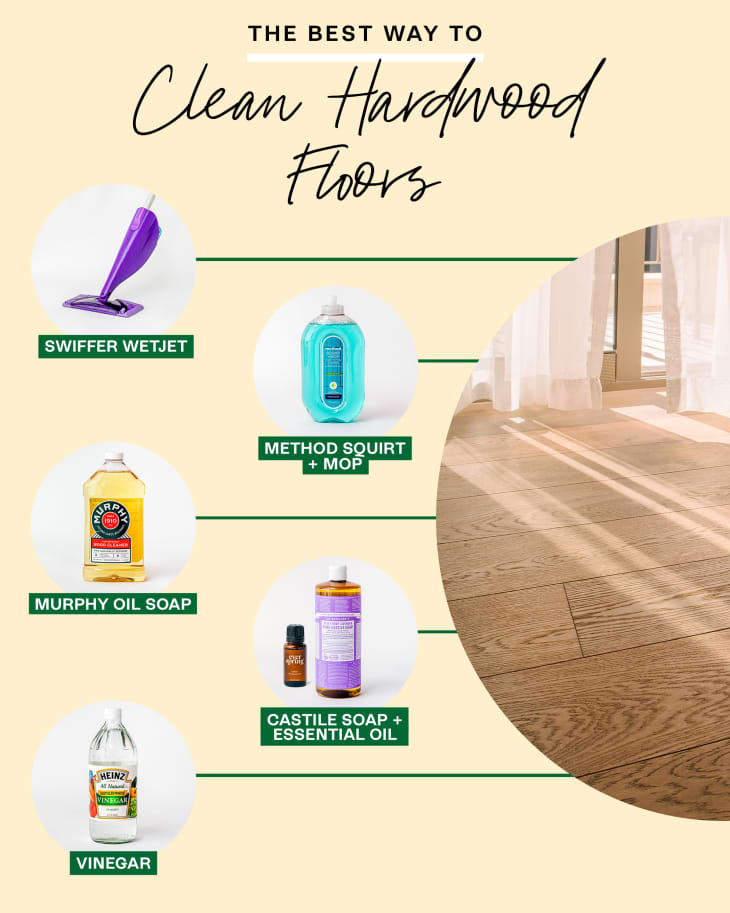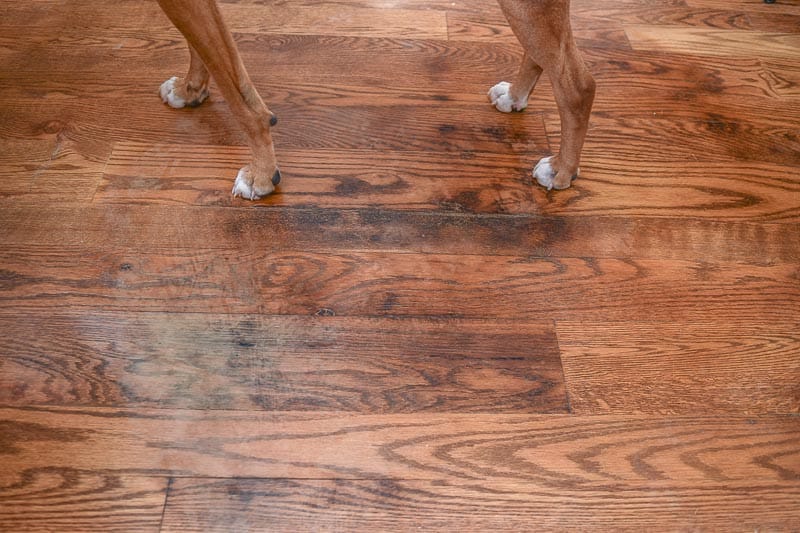To get pee out of wood floor, blot the area with paper towels, then clean with a vinegar and water solution. Wood may require refinishing.
Wood floors can add warmth and beauty to any space, but accidents happen, and cleaning up urine from wood floors can be a challenge. Whether it’s a pet accident or a potty-training mishap, it’s important to act quickly to prevent staining or damage to the wood.
We will discuss effective methods for removing pee from wood floors, ensuring your floors stay clean and pristine. With the right techniques and products, you can successfully eliminate urine odors and stains from your wood floors, restoring them to their original condition. Let’s dive in and explore the best ways to tackle this common issue.

Credit: www.pinterest.com
Understanding Urine Stains On Wood Floors
Causes Of Urine Stains
Pet accidents, spills, and failures in potty training can cause urine stains on wood floors.
Potential Damage
Urine stains on wood floors can lead to discoloration, odors, and even structural damage if not properly addressed.
Preventing And Minimizing Urine Stains
Preventing and Minimizing Urine Stains is crucial to maintaining the longevity of your wood floors. With the right strategies in place, you can effectively address and prevent urine stains on your wood floors.
Quick Cleanup Tips
- Act promptly to clean up urine spills immediately.
- Blot the affected area with paper towels to absorb as much urine as possible.
- Avoid rubbing the stain, as it can spread the urine deeper into the wood.
Protective Measures
- Regularly inspect areas where pets frequent for any signs of urine stains.
- Use pet-friendly cleaners that are safe for wood floors to clean up accidents.
- Apply a protective sealant to your wood floors to prevent urine from seeping in.
Proven Techniques For Removing Urine Stains
Discover effective techniques for removing urine stains from wood floors. Learn practical tips and proven methods to eliminate pee stains while preserving the integrity of your wood flooring.
When it comes to tackling a stubborn urine stain on your wood floor, it’s essential to use proven techniques for effective removal. Whether the stain is from a pet accident or a toddler’s mishap, there are several methods you can employ to tackle the issue. By knowing and implementing the right techniques, you can ensure your wood floor remains clean and free of urine stains.
Natural Cleaning Solutions
Natural cleaning solutions offer a gentle yet effective way to remove urine stains from wood floors. Using ingredients like vinegar, baking soda, and hydrogen peroxide, you can create DIY cleaning solutions that are safe for your wood floor while effectively eliminating the stain and odor. These natural remedies are also eco-friendly and budget-friendly, making them an ideal choice for many homeowners.
Commercial Stain Removers
Commercial stain removers specifically formulated for wood floors can also be an effective solution for removing urine stains. These products are designed to penetrate the wood’s surface and lift the stain while neutralizing odors. When choosing a commercial stain remover, opt for one that is specifically labeled for urine stains and follow the manufacturer’s instructions for best results.
Sanding and Refinishing
In cases where the urine stain has deeply penetrated the wood floor and cannot be removed through surface cleaning alone, sanding and refinishing may be necessary. This technique involves sanding down the affected area to remove the stained wood and then refinishing the floor to restore its natural beauty. While more labor-intensive, sanding and refinishing can effectively eliminate stubborn urine stains and restore the appearance of your wood floor.
In Conclusion, when it comes to removing urine stains from wood floors, it’s essential to choose proven techniques for effective results. Whether you opt for natural cleaning solutions, commercial stain removers, or sanding and refinishing, addressing the issue promptly can prevent long-term damage and preserve the beauty of your wood floor.

Credit: www.thekitchn.com
Special Considerations For Old Or Set-in Stains
Deep Penetration
When dealing with old or set-in urine stains on wood floors, the urine may have penetrated deep into the wood fibers. This can make it more challenging to remove the stain completely. However, there are steps you can take to minimize the impact of deep penetration and increase the chances of successfully getting pee out of the wood floor.
- Start by using a clean cloth or paper towel to blot up as much of the urine as possible. Apply gentle pressure without rubbing the stain to avoid pushing the urine further into the wood.
- After blotting up the excess urine, mix a solution of equal parts white vinegar and warm water. White vinegar is a natural cleaner that can help break down the urine components.
- Using a clean cloth or sponge, gently dab the vinegar solution onto the stained area. Allow it to sit for a few minutes to penetrate into the wood.
- Next, use a fresh cloth or paper towel to blot up the vinegar solution.
- Repeat this process of dabbing the vinegar solution and blotting it up until the urine stain becomes less visible.
Odor Elimination
Old urine stains can leave behind lingering odors even after the visible stain has been removed. To effectively eliminate these odors, follow these simple steps:
- Once you have treated the stain with vinegar, sprinkle a generous amount of baking soda over the affected area.
- Gently work the baking soda into the wood using a soft-bristled brush or your fingers. This will help neutralize the odor.
- Let the baking soda sit on the wood floor for at least 30 minutes to soak up any remaining odor.
- Afterward, vacuum the baking soda from the floor using a brush attachment.
- Finally, wipe down the area with a damp cloth to remove any residual baking soda.
These steps should help eliminate the urine odor, but if the smell persists, you may need to consider sanding and refinishing the wood floor or consulting a professional for further assistance.
Maintaining Wood Floors After Stain Removal
To effectively maintain wood floors after removing stains, start by blotting the urine with paper towels, then apply a mixture of water and vinegar, scrubbing gently with a soft cloth. Finish by drying the area thoroughly and applying a wood floor cleaner for a refreshed look.
Regular Cleaning Practices
Regular cleaning practices are essential for maintaining the appearance and longevity of your wood floors after removing urine stains. By following a consistent cleaning routine, you can prevent further damage and preserve the natural beauty of your wood floors.
One of the easiest and most effective ways to clean wood floors is to sweep or vacuum them regularly to remove everyday dirt and debris. Be sure to use a soft-bristle brush or a vacuum with a floor attachment to avoid scratching the surface.
When mopping your wood floors, always use a damp mop or cloth, rather than saturating the floor with water. Excessive moisture can cause warping, cupping, or even mold growth. Mix a mild wood floor cleaner with warm water and wring out the mop or cloth thoroughly before cleaning the floor. Remember to work in small sections and dry the floor immediately using a clean, dry towel or mop.
Preventive Maintenance
Preventive maintenance is an essential part of keeping your wood floors in pristine condition after removing urine stains. By taking proactive measures, you can minimize future accidents and protect your floors from additional damage.
Place mats or rugs near entryways to trap dirt and prevent it from being tracked onto your wood floors. Ensure that these mats have a non-slip backing to prevent accidents.
Consider using protective pads or coasters under furniture legs to prevent scratches and dents. These pads act as a buffer between the furniture and the floor, reducing the risk of permanent damage.
Avoid wearing high heels or shoes with sharp objects on your wood floors, as they can easily cause scratches or gouges. Encourage family members and guests to remove their shoes when entering your home to minimize the risk of accidental damage.
Regularly trim your pet’s nails to prevent them from scratching the wood floors. Additionally, clean up any pet accidents immediately to avoid further staining or odor issues.
By implementing these regular cleaning practices and preventive maintenance measures, you can ensure the long-term beauty and durability of your wood floors. Remember, consistency is key when it comes to maintaining the health and appearance of your wooden surfaces.

Credit: marialouisedesign.com
Frequently Asked Questions For How To Get Pee Out Of Wood Floor
How Do You Fix Pee On Hardwood Floors?
To fix pee on hardwood floors, blot the area with a paper towel, then clean with a solution of water and vinegar. Sand and refinish the spot if needed for deeper stains.
Does Urine Damage Wood?
Yes, urine can damage wood as it contains acids and salts that can cause discoloration and deterioration. It’s essential to clean and treat the affected area promptly to prevent permanent damage.
Does Human Urine Damage Hardwood Floors?
Yes, human urine can damage hardwood floors.
How Do You Get Urine Smell Out Of Wood Subfloor?
To remove urine smell from a wood subfloor, mix equal parts water and vinegar, apply the solution to the affected area, and scrub gently. Rinse with water, then sprinkle baking soda on the surface and leave it overnight. Vacuum up the baking soda the next day.
Conclusion
Getting pee out of a wood floor can be a challenging task, but with the right techniques and solutions, it is possible to effectively remove the odor and stains. By using natural ingredients like vinegar and baking soda, or specific enzyme-based cleaners, you can restore your wood floor to its original condition.
With patience and persistence, you can overcome this common household issue and keep your floors looking fresh and clean.


